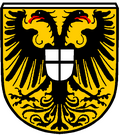Kaiserswerth
Kaiserswerth is a settlement with a more than 1,000-year history. It is one of the oldest parts of Düsseldorf.[1]
Geography
It is in the north of Düsseldorf, next to the river Rhine. Kaiserswerth has 7,712 inhabitants and an area of 4.71 km².
History
About the year 700 the monk St. Suitbert founded a Benedictine-abbey there. It was destroyed 88 years later.
The Kaiserpfalz (temporary seat of the Holy Roman Emperor) was built in 1045.
In 1062 the young German King Heinrich IV (still a child) was kidnapped by the archbishop of Cologne.
In 1174 Friederick I Barbarossa moved the Rhine customs collection to Kaiserswerth. So the bishop took over control over the whole empire.
Following emperors used Kaiserswerth as temporary seat like as prison for high-range prisoners.
Between 1212 and 1215 the Count of Berg tried to get out prisoners and made the ground around the Castle dry.
In 1273 the Emperor pledged Kaiserswerth to the archbishop of Cologne.
In 1689 Kaiserswerth was particularly destroyed by France during the War of the Palatine Succession. During the Spanish war of succession the Bishop of Cologne stayed with France.
Kaiserswerth got a French garrison. In 1702 the city was therefore besieged by the Grand Alliance. After that war the castle was mostly destroyed.
In the 19th century Kaiserswerth was famous by its deaconess clinic. Florence Nightingale visited in 1850 and learned from Pastor Theodor Fliedner and the deaconesses working there for the sick and the deprived. Nightingale published The Institution of Kaiserswerth on the Rhine, for the Practical Training of Deaconesses, etc. in 1851 - her first publication.
Kaiserswerth became a part of Düsseldorf in 1929.
Kaiserswerth Media
Kaiserswerth in 1646, engraving by Matthäus Merian.
Map of Düsseldorf, showing Kaiserswerth (in red) within Borough 5 (in pink).
References
- ↑ Florence Nightingale and Lynn McDonald, ed. (2010). "An introduction to Vol 14". Florence Nightingale: The Crimean War. Wilfrid Laurier University Press. ISBN 978-0889204690.
Other websites
| Wikimedia Commons has media related to Lua error in Module:Commons_link at line 62: attempt to index field 'wikibase' (a nil value).. |
- Kaiserswerth in Spanish succession war 1702 Archived 2016-08-28 at the Wayback Machine






